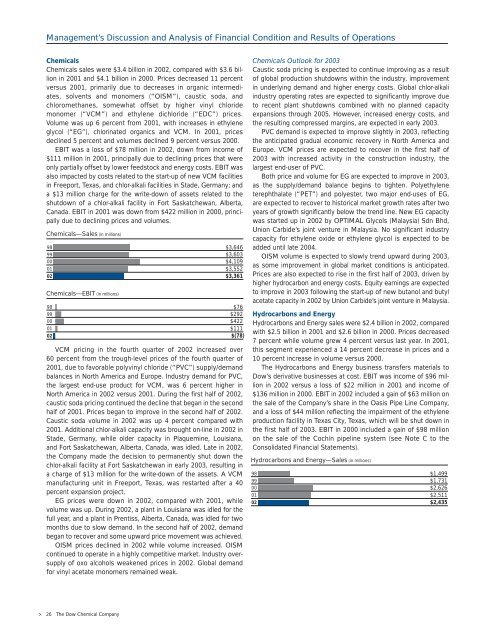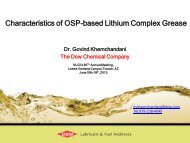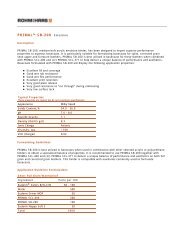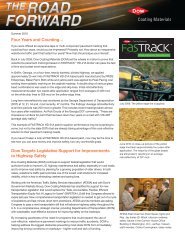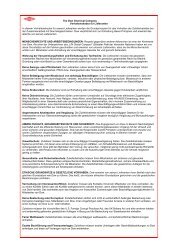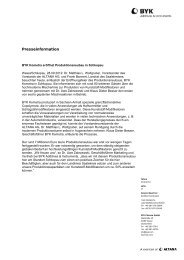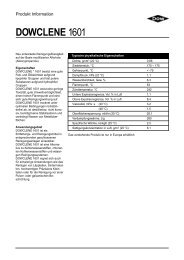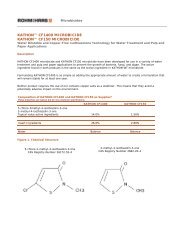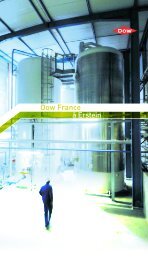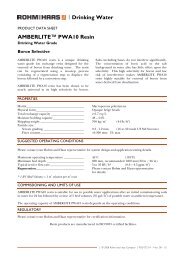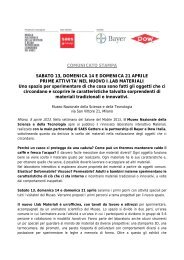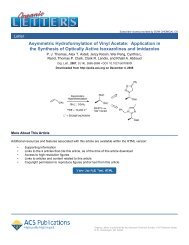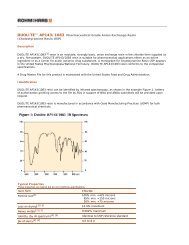Focus - The Dow Chemical Company
Focus - The Dow Chemical Company
Focus - The Dow Chemical Company
Create successful ePaper yourself
Turn your PDF publications into a flip-book with our unique Google optimized e-Paper software.
Management’s Discussion and Analysis of Financial Condition and Results of Operations<br />
<strong>Chemical</strong>s<br />
<strong>Chemical</strong>s sales were $3.4 billion in 2002, compared with $3.6 billion<br />
in 2001 and $4.1 billion in 2000. Prices decreased 11 percent<br />
versus 2001, primarily due to decreases in organic intermediates,<br />
solvents and monomers (“OISM”), caustic soda, and<br />
chloromethanes, somewhat offset by higher vinyl chloride<br />
monomer (“VCM”) and ethylene dichloride (“EDC”) prices.<br />
Volume was up 6 percent from 2001, with increases in ethylene<br />
glycol (“EG”), chlorinated organics and VCM. In 2001, prices<br />
declined 5 percent and volumes declined 9 percent versus 2000.<br />
EBIT was a loss of $78 million in 2002, down from income of<br />
$111 million in 2001, principally due to declining prices that were<br />
only partially offset by lower feedstock and energy costs. EBIT was<br />
also impacted by costs related to the start-up of new VCM facilities<br />
in Freeport, Texas, and chlor-alkali facilities in Stade, Germany; and<br />
a $13 million charge for the write-down of assets related to the<br />
shutdown of a chlor-alkali facility in Fort Saskatchewan, Alberta,<br />
Canada. EBIT in 2001 was down from $422 million in 2000, principally<br />
due to declining prices and volumes.<br />
<strong>Chemical</strong>s—Sales (in millions)<br />
98 $3,646<br />
99<br />
$3,603<br />
00<br />
$4,109<br />
01<br />
$3,552<br />
02<br />
$3,361<br />
<strong>Chemical</strong>s—EBIT (in millions)<br />
98 $76<br />
99<br />
$292<br />
00<br />
$422<br />
01<br />
$111<br />
02<br />
$(78)<br />
VCM pricing in the fourth quarter of 2002 increased over<br />
60 percent from the trough-level prices of the fourth quarter of<br />
2001, due to favorable polyvinyl chloride (“PVC”) supply/demand<br />
balances in North America and Europe. Industry demand for PVC,<br />
the largest end-use product for VCM, was 6 percent higher in<br />
North America in 2002 versus 2001. During the first half of 2002,<br />
caustic soda pricing continued the decline that began in the second<br />
half of 2001. Prices began to improve in the second half of 2002.<br />
Caustic soda volume in 2002 was up 4 percent compared with<br />
2001. Additional chlor-alkali capacity was brought on-line in 2002 in<br />
Stade, Germany, while older capacity in Plaquemine, Louisiana,<br />
and Fort Saskatchewan, Alberta, Canada, was idled. Late in 2002,<br />
the <strong>Company</strong> made the decision to permanently shut down the<br />
chlor-alkali facility at Fort Saskatchewan in early 2003, resulting in<br />
a charge of $13 million for the write-down of the assets. A VCM<br />
manufacturing unit in Freeport, Texas, was restarted after a 40<br />
percent expansion project.<br />
EG prices were down in 2002, compared with 2001, while<br />
volume was up. During 2002, a plant in Louisiana was idled for the<br />
full year, and a plant in Prentiss, Alberta, Canada, was idled for two<br />
months due to slow demand. In the second half of 2002, demand<br />
began to recover and some upward price movement was achieved.<br />
OISM prices declined in 2002 while volume increased. OISM<br />
continued to operate in a highly competitive market. Industry oversupply<br />
of oxo alcohols weakened prices in 2002. Global demand<br />
for vinyl acetate monomers remained weak.<br />
> 26 <strong>The</strong> <strong>Dow</strong> <strong>Chemical</strong> <strong>Company</strong><br />
<strong>Chemical</strong>s Outlook for 2003<br />
Caustic soda pricing is expected to continue improving as a result<br />
of global production shutdowns within the industry, improvement<br />
in underlying demand and higher energy costs. Global chlor-alkali<br />
industry operating rates are expected to significantly improve due<br />
to recent plant shutdowns combined with no planned capacity<br />
expansions through 2005. However, increased energy costs, and<br />
the resulting compressed margins, are expected in early 2003.<br />
PVC demand is expected to improve slightly in 2003, reflecting<br />
the anticipated gradual economic recovery in North America and<br />
Europe. VCM prices are expected to recover in the first half of<br />
2003 with increased activity in the construction industry, the<br />
largest end-user of PVC.<br />
Both price and volume for EG are expected to improve in 2003,<br />
as the supply/demand balance begins to tighten. Polyethylene<br />
terephthalate (“PET”) and polyester, two major end-uses of EG,<br />
are expected to recover to historical market growth rates after two<br />
years of growth significantly below the trend line. New EG capacity<br />
was started up in 2002 by OPTIMAL Glycols (Malaysia) Sdn Bhd,<br />
Union Carbide’s joint venture in Malaysia. No significant industry<br />
capacity for ethylene oxide or ethylene glycol is expected to be<br />
added until late 2004.<br />
OISM volume is expected to slowly trend upward during 2003,<br />
as some improvement in global market conditions is anticipated.<br />
Prices are also expected to rise in the first half of 2003, driven by<br />
higher hydrocarbon and energy costs. Equity earnings are expected<br />
to improve in 2003 following the start-up of new butanol and butyl<br />
acetate capacity in 2002 by Union Carbide’s joint venture in Malaysia.<br />
Hydrocarbons and Energy<br />
Hydrocarbons and Energy sales were $2.4 billion in 2002, compared<br />
with $2.5 billion in 2001 and $2.6 billion in 2000. Prices decreased<br />
7 percent while volume grew 4 percent versus last year. In 2001,<br />
this segment experienced a 14 percent decrease in prices and a<br />
10 percent increase in volume versus 2000.<br />
<strong>The</strong> Hydrocarbons and Energy business transfers materials to<br />
<strong>Dow</strong>’s derivative businesses at cost. EBIT was income of $96 million<br />
in 2002 versus a loss of $22 million in 2001 and income of<br />
$136 million in 2000. EBIT in 2002 included a gain of $63 million on<br />
the sale of the <strong>Company</strong>’s share in the Oasis Pipe Line <strong>Company</strong>,<br />
and a loss of $44 million reflecting the impairment of the ethylene<br />
production facility in Texas City, Texas, which will be shut down in<br />
the first half of 2003. EBIT in 2000 included a gain of $98 million<br />
on the sale of the Cochin pipeline system (see Note C to the<br />
Consolidated Financial Statements).<br />
Hydrocarbons and Energy—Sales (in millions)<br />
98 $1,499<br />
99<br />
$1,731<br />
00<br />
$2,626<br />
01<br />
$2,511<br />
02<br />
$2,435


